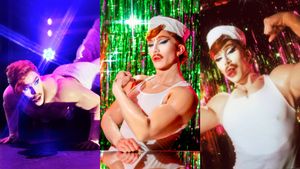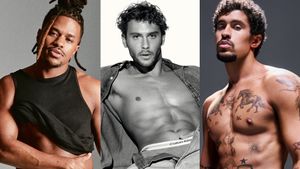When Ronson Rowley was a teen, he said he used to sneak into a nightclub called the Ten Bar. “It was the only black gay club here in Indianapolis,” he recalled. One night he ran into his uncle.“He looked me dead in the face,” he recalled. “And [he] said what are you doing here? I said, the same thing you’re doing here.”
Today Rowley works as a HIV and STI prevention ambassador, sharing advice of his own with other young black men.
Every month he goes to the Red Ribbon Rumble, an LGBT ball put on by Brothers United, an HIV and STI prevention group in Indianapolis. Rowley is popular here --he is a legend for his runway walk-- and he uses his influence to casually talk up HIV testing and prevention with his peers.
Since it started in Harlem in the 1980s, ballroom culture has been an anchor for LGBT black and Latino communities everywhere. At each ball, contestants either strut or dance their way down a catwalk, showing off their moves - spinning, duck walking, corkscrew dipping to the floor. Some dress in drag. Some dress in a polo shirt and baseball cap. The scene is about more than just the competitions--for many men, it’s where they find family and community. And it’s a natural place to try grassroots HIV prevention. Black men who have sex with men make up the largest share of new HIV cases. Yet funding for prevention and health care isn’t targeted toward this community.
“The proportion of services does not match the proportion of men who are becoming affected,” said Gregorio Millet, vice president and director of public policy for amfAR. He explained that most services are geared toward injection drug users and straight people. This leaves grassroots groups to pick up the slack. HIV prevention groups like Brothers United have started peer education initiatives in several cities, often embedding in the ballroom scene. This includes outreach at events like the annual Latex Ball in New York City hosted by the group Gay Men’s Health Crisis and balls put on by several LGBT groups in Baltimore.
Millet thinks this approach can be effective. “People are more likely to listen to their peers about health information or to get tested for HIV with their friends, so these approaches do work [in] increasing awareness as well as HIV diagnoses,” he wrote in an email.
Like many HIV experts, he cautions that something must be done to reach this community, including more funding. “If we continue to ignore where the greatest number of infections take place then we’re going to confine ourselves to another two three decades of an HIV epidemic in the United States,” he said.
Rowley said part of what inspired him to get into peer education was seeing many younger men in particular who didn’t seem to know how to prevent HIV. “Like a person will tell me, ‘Hey I’m positive, and you know how can I get help with this?’ And in my head I’m thinking like, oh my God, you’re only like 15 or 16,” he said.
He said HIV status was the elephant in the room in his community. It’s on people’s minds, but “nobody wants to talk about it.”
Overall HIV rates have gone down steadily for the last several years, but not for black and Latino gay and bi men (or trans women). Black men are still the group most likely to get HIV, with over 10,000 new cases reported in 2015, out of 37,600 total new cases. (Of those, 38 percent were under the age of 24.) In a report out last year, the CDC projected that half of black gay and bi men will get it in their lifetime--unless prevention efforts are stepped up. This is compared to a lifetime risk of 1 out of 99 for Americans in general. Yet this group also is least likely to get on PrEP, or pre-exposure prophylaxis, a drug that effectively prevents HIV transmission. Only about 10 percent of the people taking PrEP are black, according to a study from the drug’s maker Gilead. That’s where outreach like Rowley is doing can help, explaining how PrEP works, trying to dispel misconceptions and stigma. People in the ballroom community look up to him--they listen to him.
“We already have names in the ballroom [community] and so a lot of them respect us and look up to us so they’re like, ‘OK so if Ronson is in the process of getting PrEP then maybe I should do that too,’” said Rowley.
He said he himself didn’t know much about PrEP until recently, when he went through the training with Brothers United to become an ambassador. His doctor had never mentioned it to him.
At the Red Ribbon Rumble in November, the party got started around midnight. In between performers, the MC announced free HIV and STI tests were available in a back room. A few people headed back to get their cheeks swabbed to test for HIV or their blood drawn for STI tests. Brothers United provides these tests for free and helps host these monthly balls. Though he wasn’t competing that night, Rowley got a special call-out from the MC:
“When I think about runway, when I think about runway, there’s only one my son. Ronson Balenciaga,” the MC boomed. “It’s your runway extraordinaire, runway the ruler... Put your hands together for Ronson Balenciaga.
”Rowley walks the runway under the name Ronson Balenciaga, the last name inspired by the luxury designer.
When the MC called his name, Ronson coolly strutted up and down the floor in a black t-shirt and jeans. Other nights he’s competed in S&M and haute couture inspired looks, like a bird-cage headpiece, fishnets, and a whip.Rowley said when he first came out, his mom wasn’t accepting, and he took refuge in the ballroom community.
“That was my way to go and be around other people like me and express myself and be just as gay as I wanted to be,” he said.But now, his mom has come around, he said. She even went to a ball with him recently."
And she loved it! For one she actually got to finally see what a ball was like and then...for her to come around and really enjoy herself I enjoyed that,“ Rowley said.
And when the MC made the announcement about HIV tests, Rowley’s mom took advantage of the free test to find out her own status.
This story was produced by Side Effects Public Media, a reporting collaborative focused on public health.
























































































